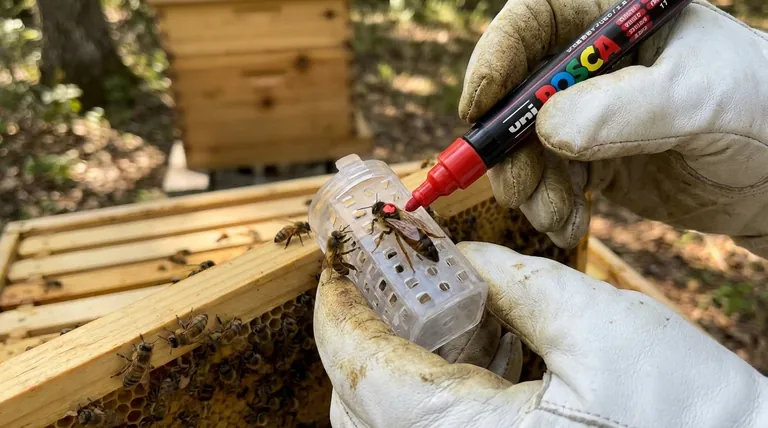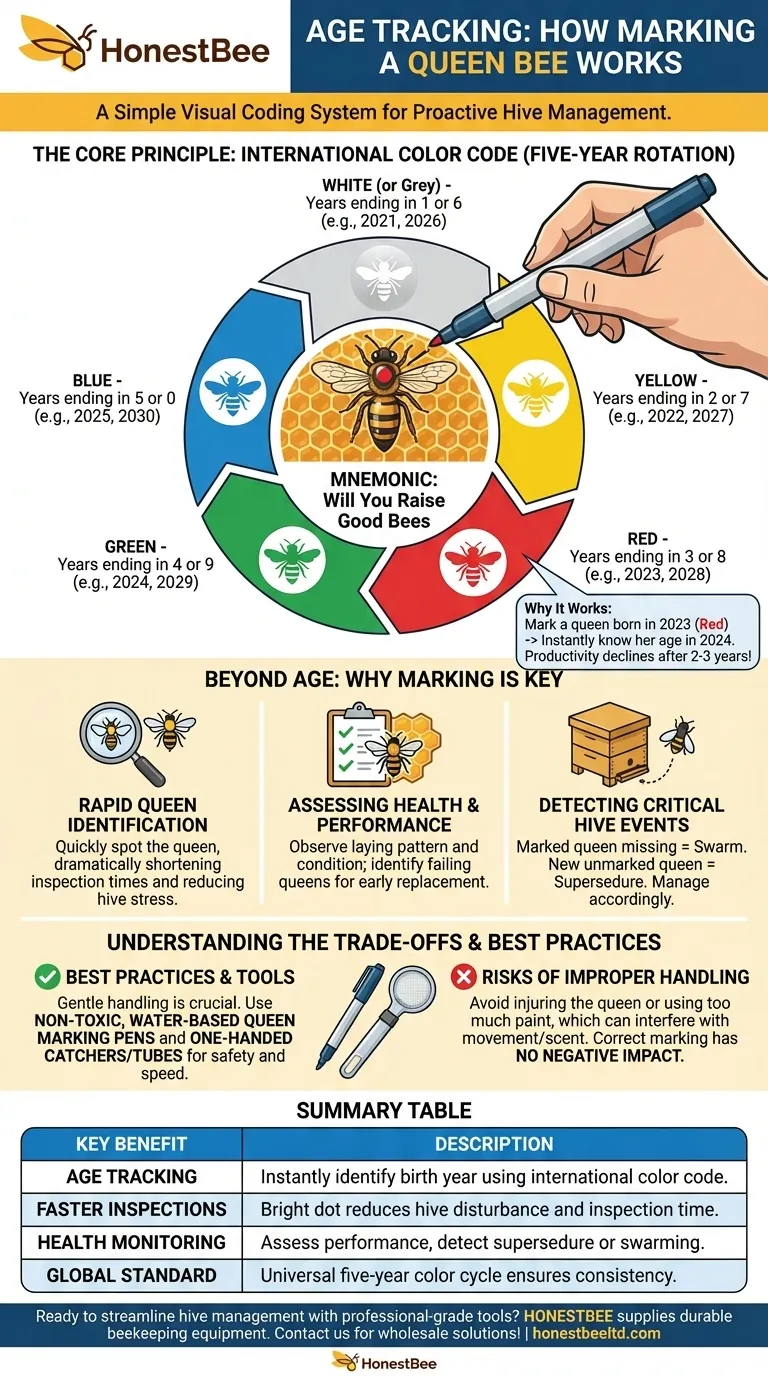At its core, marking a queen bee for age is a simple visual coding system. Beekeepers use a specific color of non-toxic paint on the queen's thorax that corresponds to the year she was born or introduced to the hive. This allows for immediate age identification during an inspection without needing to consult written records.
The practice of marking a queen is about transforming an observation into actionable data. It moves beyond simply finding the queen to instantly understanding her age and history, which is fundamental for proactive and efficient hive management.

The Core Principle: The International Color Code
The system for tracking a queen's age is standardized globally to ensure consistency. It operates on a five-year cycle, with each color corresponding to the final digit of the year.
The Five-Year Rotation
The color code is always the same, making it a universal language among beekeepers. The sequence is easy to remember with the mnemonic "Will You Raise Good Bees."
- White (or Grey): Years ending in 1 or 6.
- Yellow: Years ending in 2 or 7.
- Red: Years ending in 3 or 8.
- Green: Years ending in 4 or 9.
- Blue: Years ending in 5 or 0.
Why This System Works
By marking a queen born in 2023 with a red dot, a beekeeper can instantly recognize her age during a 2024 inspection. This immediate data point is critical because a queen's productivity typically declines after two or three years.
Beyond Age: Why Marking is a Keystone Practice
While age tracking is a primary benefit, marking the queen provides several other advantages that streamline hive management and improve colony health.
Rapid Queen Identification
An unmarked queen can be incredibly difficult to find among tens of thousands of other bees. A brightly colored dot on her thorax makes her stand out immediately.
This dramatically shortens inspection times, which in turn reduces the stress and disturbance to the colony.
Assessing Queen Health and Performance
Once you find the marked queen, you can more easily assess her work. You can observe her laying pattern and physical condition to ensure she is healthy and productive.
A failing queen, regardless of age, can be identified and replaced before the colony's population declines significantly.
Detecting Critical Hive Events
A marked queen provides clear evidence of the hive's status. If you find your red-marked queen from last year is gone and a new, unmarked queen is present, you know the colony has superseded her.
If the hive is suddenly queenless and your marked queen is missing, it's a strong indicator that a swarm has occurred. This knowledge allows you to manage the colony appropriately.
Understanding the Trade-offs and Best Practices
Marking a queen is an overwhelmingly positive practice, but it's a delicate procedure that requires the right approach to avoid harming the queen or the colony.
The Risk of Improper Handling
The primary risk is injuring the queen. She must be handled gently and held for the briefest possible time. Applying too much paint can interfere with her movement or scent.
However, when done correctly, marking has no negative impact on her acceptance by the hive, her mating flights, or her ability to lay eggs.
The Right Tools for the Job
Using proper equipment is essential for safety and success. Beekeepers use specialized queen marking pens filled with non-toxic, water-based paint.
Tools like a one-handed queen catcher or a marking tube can help immobilize her gently, making the process faster and safer, especially for less experienced beekeepers.
Making the Right Choice for Your Apiary
Ultimately, marking your queen is a management decision based on your beekeeping goals.
- If your primary focus is efficiency and time savings: Marking is essential, as it drastically reduces the time needed to find the queen during inspections.
- If your primary focus is tracking performance and genetics: Marking is non-negotiable for keeping accurate records on queen productivity and lineage.
- If your primary focus is minimal intervention: You might choose not to mark, but you accept the trade-off of longer inspections and less certainty about the queen's status.
Adopting this simple practice gives you a powerful tool for making informed decisions and managing a healthier, more productive colony.
Summary Table:
| Key Benefit | Description |
|---|---|
| Age Tracking | Instantly identify the queen's year of birth using the international color code (e.g., red for 2023/2028). |
| Faster Inspections | Brightly colored dot makes the queen easy to spot, reducing hive disturbance and inspection time. |
| Health Monitoring | Quickly assess queen performance, laying patterns, and detect issues like supersedure or swarming. |
| Global Standard | Universal five-year color cycle (White, Yellow, Red, Green, Blue) ensures consistency for all beekeepers. |
Ready to streamline your hive management with professional-grade tools? At HONESTBEE, we supply durable, precision beekeeping equipment—including queen marking kits and catchers—to commercial apiaries and distributors. Enhance your efficiency and colony health with our wholesale-focused solutions. Contact us today to discuss your needs and place an order!
Visual Guide

Related Products
- Queen Bee Marking Pen POSCA Queen Marking Pens for Beekeeping Bee Markers
- Queen Bee Marking Pen UNI Medium Point for Queen and Bee Marking
- Queen Bee Marking Tube Cage Bottle Catcher Holder with Clear Plastic Plunger Marker
- Professional Engraved Round Hive Number Tags for Beekeeping
- Professional Galvanized Hive Strap with Secure Locking Buckle for Beekeeping
People Also Ask
- What are the benefits of marking a queen bee? Boost Efficiency & Hive Health
- What is the purpose of a queen marking pen in beekeeping? Essential for Efficient Hive Management
- What are the advantages of marking a queen bee? Achieve Precision and Confidence in Hive Management
- What should you do immediately after marking a bee? Ensure a Clean, Durable Mark with This Key Step
- What type of markers are commonly used for marking Queen bees? Choose the Safe, Non-Toxic Standard



















